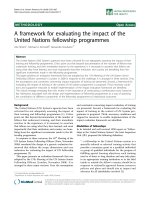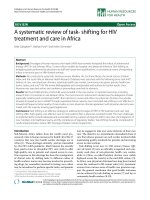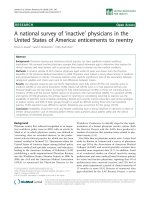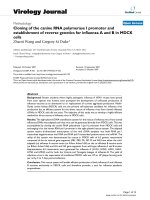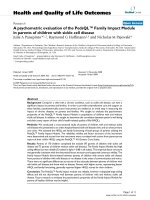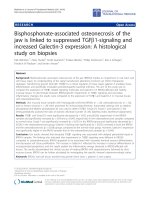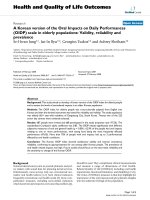Báo cáo sinh học: "A case study of the College English Test and ethnic minority university students in China: negotiating the final hurdle" pptx
Bạn đang xem bản rút gọn của tài liệu. Xem và tải ngay bản đầy đủ của tài liệu tại đây (204.12 KB, 11 trang )
RESEARC H Open Access
A case study of the College English Test and
ethnic minority university students in China:
negotiating the final hurdle
Bob Adamson
1*
and Beibei Xia
2
* Correspondence: badamson@ied.
edu.hk
1
Department of International
Education and Lifelong Learning,
Hong Kong Institute of Education,
10 Lo Ping Road, Tai Po, New
Territories, Hong Kong SAR
Full list of author information is
available at the end of the article
Abstract
The College English Test (CET) is one of the entry and exit requirements for
undergraduate study for any major at universities in China. Its high status reflects the
prominent role ascribed to the English language in the nation’s economic
development. For many students from China’s 55 ethnic minority groups, the CET
represents a formidable hurdle: they typically received piecemeal expo sure to
English, as their primary and secondary schooling was conducted in relatively under-
resourced areas. The paper reports the case of a university that lowered the CET
entry requirements for these disadvantaged students. However, similar adjustments
were not made to the exit requirements, resulting in the failure of hundreds of
ethnic minority students to graduate. A subsequent court decision ruled that the
university had not breached any laws. The paper discusses the questions of social
justice that are posed by the university’s actions in particular and by the importance
attached to English in higher education in general, and concludes that there is a fine
line between affirmative action and discrimination, and the university’s language
policy failed to take full account of the reality facing many ethnic minority students.
Keywords: English as a foreign language, testing, ethnic minority, social justice,
China
Background
Language policies in education involve state authorities making important decisions
that have implicati ons for social justice (Mohanty 2009). These policies influence deci-
sions that determine the language(s) to be taught in the curriculum, the time and
resources to be allocated, and the medium of instruction to be used for t he subjects
across the curriculum. They therefore impact on the opportunities for linguistic minor-
ity students to access effective education that allows them to maintain t heir own cul-
tural identity and to participate in the mainstream society. The factors that need to be
taken into consideration in language policy-making are often complex (language rights,
resources, curriculum ideologies, political and economic exigencies, societal expecta-
tions of e ducation, and so on) and can be characterized as dilemmas rather than as
problems, in that dilemmas cannot be resolved–formulating a response to a dilemma
results in the creation of a new dilemma (Ogawa et al. 1999). The complexity and
number of dilemmas increase exponentially when the language policy is concerned
with trilingualism rather than monolingualism or bilingualism.
Adamson and Xia Multilingual Education 2011, 1:1
/>© 2011 Adamson and Xia; licensee Springer. This is an Open Access article distribute d under the terms of the Creative Commons
Attribution License (http:// creativecommons.o rg/licenses/by/2.0), which permits unrestricted use, distribution, and reproduction in
any medium, provided the original work is properl y cited.
The focus of this paper is a policy establishedbyatertiaryinstitutioninChinacon-
cerning the English language requirements for admission and graduation to be a ttained
by non-English majors, and the implications of this policy for ethnic minority students.
Unl ike their majority Han counterparts who studied only Chinese (oral Putonghua and
standard written Chinese) and English, these students have experienced trilingualism in
their primary and secondary education, studying their mother tongue, Chinese and Eng-
lish–since 2002, English has also been taught in primary schools, where circumstances
permit (Lam 2007). However, many ethnic minority studen ts come from low-resourced
areas where English provision is difficul t. Given the importance of English for entrance
into and graduation from tertiary institutions in China (Adamson 2004; Lam 2005,
2007), these students could easily find themselves in a disadvantaged position when
competing with Han students for access to the limited places available in higher educa-
tion and when they seek to meet all the requirements to complete their s tudies. The
issues surrounding access to and graduation from tertiary education create dilemmas, as
English can be socially divisive. As Skutnabb-Kangas et al. (2009: 327) argue:
What needs to be resisted and counteract ed is policies that privilege English at the
expense of other languages. English opens doors, yes, but it closes others. English
is an open sesame f or some p eople and some purposes, but it serves to condemn
others to poverty and oblivion.
This paper is a document ary study of a specific university ’s language p olicy. While
this university’s policy is typical of those adopted by many tertiary institutions i n
China, it is noteworthy in that it gave rise to a court case challenging the policy. The
paper is framed around issues of social equity and justice, and draws upon six ques-
tions proposed by Tollefson (2002, pp.13-14) for analyzing language in education poli-
cies in terms of the impact on the language rights of minority groups:
1. What are the major forces affecting language policies in education and how do
these forces constrain policies and public discussion of policy alternatives?
2. How do state authorities use educational language policies to manage access to
language rights and language education, and what are the consequences of specific
state programmes and policies for language minority communities?
3. How do state authorities use language policy for the purpose of political and cul-
tural governance?
4. How do language policies in education help to create, reduce or sustain political
conflicts among different ethno-linguistic groups?
5. How are local policies and programmes in language education affected by global
processes such as colonialism, decolonisation, the spread of English and the growth
of the integrated capitalist economy?
6. How can indigenous peoples and other language minorities develop educati onal
policies and programmes that serve their social and linguistic needs, in the face of
significant pressure exerted by more powerful social and ethno-linguistic groups?
The paper begins by reviewing the role and status of ethnic minority languages, Chi-
nese and English in education policies and practices in China. It then focuses on the
Adamson and Xia Multilingual Education 2011, 1:1
/>Page 2 of 11
English language requirements for university entrance and graduation –the language
policy at the heart of the controversy in the individual institution. The following sec-
tions present the details of the controversy, and addresses the six questions outlined
above. The paper concludes by discussing the implications of the policy for social
equity.
Language education policies for ethnic minorities in China
China has 55 official ethnic minority groups numbering approximately 106 million
people (China National Commission for UNESCO 2004). They tend to be located in
the peripheral regions of the country, often in remote, economically-underdeveloped
rural areas far from the more affluent eastern seaboard. Some of the groups are assimi-
lated into the mainstream culture; others have preserved a strong sense of distinct
identity while maintaining a high degree of engagement with the Hans; other groups
have tended to resist what they consider to be Han imperialism (Adamson & Feng
2009). Language education policies for the ethnic minority groups have varied over
time and accordi ng to the particular politics of a locality (as regions have considerable
autonomy)–the ethnic minority language has either been supported and cultivated in
the educat ion system or s uppressed (Lam 2005; Adamson & Feng 2009). Currently, as
noted above, national language education policies seek to foster trilingualism in ethnic
minority students: the minority language, Chinese and English. In regions where trilin-
gualism is promoted in a supportive manner, the minority language is taught in pri-
mary schools (though it is not usually taught higher in the system) in order to
preserve the cultural identity of the students. Chinese, the national langu age, is taught
for s ocial, political and economic unity, and proficiency is crucial for ethnic mino rity
students to progress in secondary schools, where they would usually join students
from other minorities and Han students, and where Chinese is the medium of instruc-
tion as well as the lingua franca for social interaction (Adamson & Feng 2009). English
is taught from Primary 3 as a means to facilitate the international economic moderni-
zation of China.
The linguistic pressure on minority students arises from the nee d to develop compe-
tence in Chinese in order to access secondary education, and English in order to access
tertiary education. The latter language is particularly problematic for minority students.
WhileinsomeChinesecities,Englishisthe medium of instruction for mathematics,
science and other subjects in selected secondary schools and (in some experimental
projects) for primary education, and there are booming mar kets in private tuition and
eveni ng schools for children and adults, and in books, magazines, on-line learning and
educational resources, ethnic minority students, being located in more remote areas
and belonging to lower socio-economic groups, are generally unable to enroll in elite
schools or to afford supplementary resources. English has been introduced haphazardly
in the schools they attend, depending upon the availability of resources and particularly
of qualified t eachers. A common trend is for s chools to recruit Putonghua-speaking
teachers of English in the absence of teachers able to use the local ethnic languag e to
teach the subject, which means that the students are learning their third language
through their second langu age (Feng 2007; Adamson & Feng 2009). These constraints
have implications for the opportunities for ethnic minority students to gain admission
to higher education.
Adamson and Xia Multilingual Education 2011, 1:1
/>Page 3 of 11
Entrance requirements in English for admission to higher education
Competence in English has been a requirement for admission to higher education
since1978,and,since1984,ithasbeenoneofthesubjectsthatmakeuptheCollege
Entrance Examination. A written English test is compulsory for all students who wish
to gain a place at university. (Scores from oral examinations are included in the total
score and serve only as a reference for potential English majors and other relevant spe-
cialisms.) The weighting of the English test in t he overall College Entrance Examin a-
tion has been increased over the past two decades from 100 points to 120 points in
the early 1990s, and later to 150 points (Jin & Cortazzi 2003). The current allocation
of 150 points is out of a total of 750 points in the national test paper. In some pro-
vinces and municipalities that are authorized to set their own College En trance Exami-
nation test papers, English accounts for a higher proportion of the total score. For
instance, the weighting of English is 150 out of 630 points in Shanghai and 120 out of
480 points in Jiangsu Province.
The College English Test (CET) is a nat ional examination administered by the Min-
istry of Education that was established in 1987. Its official purpose is to evaluate objec-
tively and accurately the English proficiency of non-English majors in institutions of
higher learning in China, in order to improve the quality of English teaching provided
for these students (National College English Testing Committee 2006, p.3). A battery
of College English Tests is conducted throughout the country under the administration
of the National College English Testing Commit tee. There are six progressive bands in
the national College English Teaching Syll abus published in 1999. The CET Band 4
(CET-4) is designed for second-year students who have finished the College English
Band 1 to Band 4 syllabus and the CET Band 6 (CET-6) for third-year students who
have completed Band 5 to Band 6. Three major phases are discernible in the historical
development of the CET (Zheng & Cheng 2008; Chen & Klenowski 2009).
CET-4 was initiated in September 1987, and CET-6 in January 1989. Fundamental
components of the test were laid out in the first decade. The test scores were based on
a 100-point scale, of which a score of 60 points was a passing grade. Certificates were
issued by the Department of Higher Education in the Ministry of Educat ion. For those
whose score was 80 or above, “Excellent” was recorded on the certificate. The second
phase, 1997-2005, witnessed test format changes. In 1997, dictation was added to the
listening section, and translation from English to Chinese in the reading part. In 1999,
a College English Test-Spoken English Test (CET-SET) was introduced to examine
studen ts’ oral communication ability on familiar topics. The CET-SET was available to
students who had passed CET-4 with a score of 80 or above, or CET-6 with a score of
75 or above. In the third phase, CET was revamped in terms of test content, format
and scoring system in 2006. The most rema rkable change made in this stage was the
elimination of the distinction between pass and fai l. As of Januar y 2005, a full score of
710 was adopted in the CET score report system. Instead of a certificate, students who
scoreabove220areawardedatranscriptissuedbytheNationalCET-4andCET-6
Commission on behalf of the Department of Higher Education of the National Minis-
try of Education (National College English Testing Committee 2006). A computer-
based CET was trialled by 50 higher educati on institutions for the first time on 21
December, 2008. Compared with the traditio nal written test, the computer-based CET
makes full use of multi-media, placing more emphasis on the listening section. The
Adamson and Xia Multilingual Education 2011, 1:1
/>Page 4 of 11
adoption of such technology is likely to mark a new era in the development of the
CET.
Statistics show that CET has ranked as the largest test of English as a foreign lan-
guage in the world (Cheng 2008; Zheng & Cheng 2008). CET-4 and CET-6 are held
twiceannually.In1987,thenumberofstudents who took part in the first CET-4
stood at 100,000. By 2006, this number had skyrocketed to 13,000,000 (Zheng &
Cheng 2008). To make the numbers more manageable, from the second half of 2006,
CET was restricted to college students, and was no longer open to the public. Even
under these circumstances, about 2 million students sit for CET every year.
CET administrators claim the test has high reliability and validity (Cheng 2008; Yang
& Weir 2001; Zheng & Cheng 2008). Its credibility has bestowed high status. At the
institution level, the passing rate on the CET is often regarded as one of the criteria to
judge the prestige of a unive rsity (Cheng 2008) and CET results are regarded as the
main indicator of the quality of English teaching (Zhu 2003). For college students,
good performance in these tests represents the key to academic success as well as
affecting their life chances in gener al (Cheng 2008). CET is seen as a passport to bet-
ter-paid employment in business trading firms or joint ventures in China’s increasingly
competitive job market (Pang et al. 2002).
Language policies on university admission and graduation
The analysis in this section is concerned with the language policies relating to admission
and graduation of a university located in a major city in central China. This university is
listed in the State 211 Project, which means that it has been identified as a key institu-
tion to be upgraded to elite status nationally and to world-class standards in terms of
teaching and research in some of its discipline areas, and is placed under the direct
administration of the Ministry of Education by the authority of the State Council.
Although centrally administered, the university has a high degree of autonomy according
to higher education reforms instituted in the early 1990s (Chinese Communist Party
Central Committee 1993). These reforms are part of a transformation of China’shigher
education system to gear it to meet the needs of a market economy (Hu 2010).
The university conforms to the preferential policies for ethnic minority students set
by the st ate and provincial governments. According to the national policy (Ministry of
Education of the Peoples’ Republic of China 2009), provincial committees controlling
university admission are authorized to award ethnic minority students from remote
are as a bonus of up to 20 marks in the College Entrance Examination. In this specific
case, the Provincial Education Bureau stipulated that ethnic minority students could be
given 10 awarded marks, and the individual university would have the right to review
each case and ultimately decide whether the students would be enrolled or not.
For graduation, a large number of higher educ ation instituti ons pursue the policy of
“no CET-4 certificate, no Bachelor’s degree” (Pang et al. 2002; Cheng 2008). This lan-
guagepolicyisformulatedbyindividualinstitutions–the Ministry of Education has
never made it a requirement that performance in CET should be linked with degree
conferral. Indeed, with the introduction of the new system in 2005, the Ministry of
Education tended to play down the role of CET in graduation requirements, as it had,
to some extent, b ecome overemphasized. Nonethe less, the cachet attached to English
competence meant that many higher education institutions maintained the linkage.
Adamson and Xia Multilingual Education 2011, 1:1
/>Page 5 of 11
The university takes the view that a qual ified univ ersit y graduate from a ke y univer-
sity should possess a certain benchmarked level of English competence. Presumably on
the grounds that CET is viewed as the most mature, most valid and most widely recog-
nized English test in this context in China, the university adopted it to assess st udents’
English proficiency, and, consequently, their eligibility for degree conferral. The current
policy of the university concerning degree conferral is set out under the terms of its
Interim Provisions for Bachelor’s Degree Conferral, reviewed and passed by the 4
th
Pre-
sidential Meeting in 2005. Article 5.4 explicitly states “a B achelor’s Degree cannot be
conferred upon students whose foreign language proficiency does not meet the
requirements of the University.” This English proficiency requirement is published by
the university in the Notice on Degree Conferral Affairs each year. On 3 June, 2008,
the Academic Affairs Office of the university issu ed the Foreign Language Require-
ments of Degree Conferral to 2008 Full-time Graduates. Article 1.2 stated that “For
non-English majors, CET serves as the criterion of En glish proficiency of Bachelor’s
Degree conferral”. Article 2.1 further stipulated that “For full-time graduates, a mini-
mum score of 50 (the percentage system) or 355 (710-score-system) is the English pro-
ficiency requirement of degree conferral”.
To enable the students at the university to pass CET-4 before graduation, the univer-
sity allows non-English majors six attempts at the test. Students first sit CET-4 in their
second year in the university. If they fail, they can re-take the test up to five times.
The minimum score of 355 in the new CET-4 required for confe rral of a Bachelor’s
degree under t he terms of the university policy is, on the face of it, relatively unde-
manding, but other forms o f language support, such as courses to develop English
competence or courses delivered through the medium of English, are scarce. In the
event, since the formulation of the policy incorporating the language requirement,
hundreds of students in the university did not graduat e from their undergraduate pro-
grammes because of their failure in CET-4. In 2005 alone, for instance, some 600 com-
pleting students out of a total enrollment of 36,000 undergraduates were issued a
statement by the university inste ad of a Bachelor’ s degree certificate. The statement
made it clear that students were not awarded a degree as they had not met the mini-
mum requirements of English proficiency. Among the 600 graduates, a large number
were ethnic minority students from Inner Mongolia, Xinjiang and Ningxia.
Lawsuit over degree conferral
The link between CET and degree conferr al triggered a lawsuit against the university.
On completion of their study in 2005, five students appealed to the Ministry of Educa-
tion for “administrative reconsideration” on the grounds that they had been denied
their Bachelor’s degree due to their fail ure in CET-4. The Ministry of Education
rejected the appeal because the matter did not fall within the scope of such reviews.
The graduates then sued the university, alleging violation of The Regulations of the
People’ s Republic of China on Academic Degrees (Ministry of Education of the Peoples’
Republic of China 2004), which was adopted at the 13
th
Session of the Standing Com-
mittee of the Fifth National People’s Congress on 12 February 1980 and amended at
the 11
th
Session of the Standing Committee of the Tenth National People’sCongress
on 28 August 2004. Article 4 of these Regulations states “The bachelor’sdegreeshall
be conferred on graduates from institutions of higher learning who h ave good
Adamson and Xia Multilingual Education 2011, 1:1
/>Page 6 of 11
academic records and have attained the following academic standards: (1) having a
relatively good grasp of basic theories, specialized knowledge and basic skills in the dis-
cipline concerned; and (2) having initially acquired the ability to undertake scientific
research or to engage in a special technical work.” The students argued that the regula-
tions do not imply that a CET certificate is required for degree conferral.
The court decided in favour of the university on the basis that decisions regarding
degree conferral are a matter of institutional autonomy guaranteed by law (see Wuhan
Intermediate People’s Court 2006). Article 11 of Higher Education Law of the People’s
Republic of China (Ministry of Education of the Peoples’ Republic of China 1999)
explicitly states that “Institutions of higher learning should be geared to the needs of
society, run independently and practise democratic management in accordance with
law”. In addition, Article 25 of the Provisional Measures of the People’sRepublicof
China on Academic Degrees (Ministry of Education of the Peoples’ Republic of China
1981) stipulates, “Degree -conferring units may, in accordance with these regulations,
make rules for the degree-conferring work of their own units.” Therefore, the court
decided, making CET a prerequisite of de gree conferral did not violate the law, espe-
cially as the university had appropriately fulfilled their obligation to make known the
requirement to students.
Discussion
At the beginning of this paper, we outlined six questions posed by Tollefson (2002)
concerning the impact of languag e in education policies on the linguistic rights of eth-
nic minority groups. In this section, the discussion will focus on each q uestion in
respect of the specific language policy pursued by the university.
Major forces affecting the language policy
The policy reflects the importance attached to English in China in the preparation of
human resources for the economic development of the country. English competence is
a crucial determinant for securing employment, promotion, and overseas experiences;
it is also seen as facilitative for China’s staging of international events such as the Beij-
ing Olympic Games in 2008 and the Shangh ai World Expo in 2010, and for the
nation’s diplomatic, cultural and commercial interactions with other countries (Lam
2002; Zhu 2003; Ada mson 200 4; Feng 2005; Cheng 2008; Simpson 2008). The impor-
tance of the r oles and status accorded to the language in contemporary China has
“reached unprecedented heights, although fundamental cultural and political tensions
remain” (Gil & Adamson 2011: 30).
These tensions include the disadvantaging of ethnic m inority students because of
their limited access to English, which authoriti es have sought to mitigate by affirmative
action in university admissions. However, the strength of the status of English, its
embedding in many facets of society in China, and the use of benchm arks such as the
CET for assuring the desirable attributes of graduates all constrain the flexibility of
authorities in allowing waivers to the graduation requirements in English.
Policies, language rights and consequences
The university language policy reflects broader attitudes underpinning language in edu-
cation policies for ethnic minority groups, which either tolerates or suppresses the
Adamson and Xia Multilingual Education 2011, 1:1
/>Page 7 of 11
minority languages in the interests of national cohesion through the promotion of Chi-
nese, and international economic development through the promotion o f English
(Adamson & Feng 2009). Wittingly or unwitt ingly, by ignoring the value of minority
languages, the language policy reinforces the low status of those languages in state
institutions such as universities and therefore in society as a whole. A further conse-
quence of the policy is that, by denying graduation purely on the grounds of poor Eng-
lish proficiency, it limits the chances of ethnic minority students (and other groups
that were disadvantaged in their learning of English) to access the socio-economic ben-
efits that generally accrue to university graduates.
Political and cultural governance
Language policies are facilitated and institutionalized by systemic tools. In this case, the
tools are the regulations for admission and for gr aduation, which are contro lled either
by the central government or by the universities under the administration of the Min-
istry of Education, and the national CET assessment framework. These tools create a
narrow linguistic prof ile of the desired graduates of elite universities, thereby establish-
ing a hierarchical structure that privileges competence in English (and Chinese), and
exerts a subtractive effect on the minority languages and, by e xtension, their culture.
The comparatively low economic capital associated with most ethnic minority lan-
guages can lead to their diminished presence in the school curriculum and thus makes
the preservation and vitalization of minority cultures more difficult.
Political conflicts
The language policy is controversial and divisive. Conflicts arise partly because the pol-
icy (through omission) does not value the ethnic minority language, and partly because
it is incoherent. Ethnic minority students receive preferential treatment at entry, but
not upon graduation, and the expectation that their English competence should
improve to the extent that they fulfil standardized graduation requirements–which
might be viewed as setting a level playing field for all –is unrealistic. As a result, the
policy tends to favour the Han students, who are more likely to have received better
access to English prior to entering university.
The conflict is symptomatic of broader tensions between the Han and ethnic minori-
ties, which have centred around the issues of cultural diversity, political control and
access to economic resources (Adamson & Feng 2009).
Global processes and the integrated capitalist economy
Located in the Expanding Circle of Kachru’s (1985) “three circles” model, China’s rela-
tionship with the English language has been historically ambivalent: at times, English
has been seen as threatening national integrity; at other times, it has been viewed as a
utilitarian conduit for strengthening China’s presence and power in the world (Adam-
son 2004). The impact of globalization and the integrated capitalist economy on higher
education includes the promotion of the English language, as university curricula are
closely aligned with the economic needs of the state.
The higher status thus accorded to English can prove detrimental to lower status
languages in formal education, as well as putting pressure on the capacity of poorer
regions to provide access for schoolchildren to effective English teaching.
Adamson and Xia Multilingual Education 2011, 1:1
/>Page 8 of 11
Supportive ethnic minority language policies
Primary schools in ethnic minority-dominated regions of China often have trilingual poli-
cies: the students learn their mother tongue, Chinese and (from Primary 3) English. This
support is not extensively maintained throughout the school system. Generally speaking,
the minority language is dropped quite early, as students need to learn through the med-
ium of Chinese and develop their English competence in order to progress through sec-
ondary and tertiary education (Adamson & Feng 2009). There is no indication of support
for ethnic minority languages in the university policy discussed in this case study.
Conclusion
The university’sdegreeconferralpolicyprovidesamicrocosmicinstanceoftheten-
sions that are created by what Blachford and Jones (2011) identify as a dilemma
between policy ideals and contextual realities. The problems arising from the university
policy are an extension of the difficulties created by the trilingual education policy in
China, which envisages primary school students studying their mother tongue, Chinese
and English. Ideally, these three languages will bolster the students’ sense of cultural
identity as well as their access to mainstream education and economic opportunities,
and so the policy can be seen as collaborative and ameliorative, rather than coercive
and destructive (Adamson & Feng 2009).
The reality, however, is that the learning of English tends to flourish in regions of
China where students have the chance to interact with the language through exposure
to rich resources, which disadvantages many ethnic minority groups. Minority students
who have succeeded, against the odds, in reaching an elite university (albeit with assis-
tance, in many cases, through affirmative action) find themselves tripped by the final
hurdle–a test in a language that is an alien intruder, linguistically and culturally, and
that may have little or no relevance to the student ’s major. Despite the good intentions
of the affirmative action, the policy reality–as with many language policies affecting the
ethni c minori ty groups–is, as Blachford and Jones (2011, p.229) aver, “a highly uneven
playing field, far divorced from the policy ideal passed in Beijing”.
If the trilingual policy is to achieve its goal of equality of opportunity, and if ethnic
minority students are not to fall at the final hurdle at university, there needs to be a
comprehensive review that takes into account the realities of the rural schools and
communities where the linguisti c foundations are laid. While the court’s ruling on the
students’ challenge to the imposition of CET scores as a gradua tion requirement was
legally sound, the rationale behind such practices needs re-examination by policy-
makers so that language policies become emancipatory rather than reinforcing inequal-
ity. Key issues for policy-makers to consider include the status accorded to the English
language in the education system, and the standards that graduates are expected to
achieve in the CET, as well as the status accorded to ethnic minorit y lang uages in the
education system. A more equitable system requires a balanced approach that might
include toning down the expectations in respect of English and enhancing the commit-
ment to ethnic minority languages through explicit policies and institutional structures.
Author details
1
Department of International Education and Lifelong Learning, Hong Kong Institute of Education, 10 Lo Ping Road, Tai
Po, New Territories, Hong Kong SAR
2
Faculty of Languages, Hong Kong Institute of Education, 10 Lo Ping Road, Tai
Po, New Territories, Hong Kong SAR
Adamson and Xia Multilingual Education 2011, 1:1
/>Page 9 of 11
Authors’ contributions
Both BA and BX contributed to the conception, design, collection, analysis and interpretation of data. Both authors
read and approved the final manuscript.
Authors’ Information
Bob Adamson is Professor of Curriculum Studies at Hong Kong Institute of Education. He researches and publishes in
the fields of English language teaching, teacher education, comparative education, curriculum studies and higher
education. His books include China’s English; Curriculum, schoo ling and society (with Paul Morris); Assessment reform in
education (co-edited with Rita Berry); and Comparative education research approaches and methods (co-edited with
Mark Bray and Mark Mason). He is currently Vice President of the Comparative Education Society of Hong Kong.
Beibei Xia is an Associate Professor in the School of Foreign Languages for International Business at the Shanghai
Institute of Foreign Trade, and a doctoral student in the Faculty of Languages at Hong Kong Institute of Education.
Her research interests include business English, bilingual education and interpretation. She has published book
chapters and journal articles in these areas. She is currently working on her doctoral thesis entitled “Understanding
bilingual teaching in China’s higher education: An evaluative study of a model bilingual course“.
Competing interests
The authors declare that they have no competing interests.
Received: 12 April 2011 Accepted: 16 December 2011 Published: 16 December 2011
References
Adamson, Bob, and Anwei Feng. 2009. A comparison of trilingual education policies for ethnic minorities in China. Compare
39(3): 321–333.
Adamson, Bob. 2004. China’s English: a history of English in Chinese education. Hong Kong: Hong Kong University Press.
Blachford, Dongyan Ru, and Marion Jones. 2011. Trilingual education policy ideals and realities for the Naxi in rural Yunnan.
In English language education across Greater China, ed. Anwei Feng. 228–259. Clevedon, UK: Multilingual Matters.
Chen, Qiuxian, and Valentina Klenowski. 2009. Assessment and curriculum reform in China: the College English Test and
tertiary English as a foreign language education. Proceedings of the 2008 AARE International Education Conference.
Accessed 8 April 2011.
Cheng, Liying. 2008. The key to success: English language testing in China. Language Testing 25(1): 15–37.
China National Commission for UNESCO. 2004. Education development in China (2004). Beijing: China National Commission
for UNESCO.
Chinese Communist Party Central Committee. 1993. Outline for reform and development of education in China. Beijing:
People’s Press.
Feng, Anwei. 2005. Bilingualism for the Minor or for the Major: an evaluative analysis of parallel conceptions. International
Journal of Bilingual Education and Bilingualism 8(6): 529–551.
Feng, Anwei. 2007. Intercultural space for bilingual education. In Bilingual education in China, ed. Anwei Feng. 259–286.
Clevedon, UK: Multilingual Matters.
Gil, Jeffrey, and Bob Adamson. 2011. The English language in China: a sociolinguistic profile. In English language education
across Greater China, ed. Anwei Feng. 23–45. Clevedon, UK: Multilingual Matters.
Hu, Jianhua. 2010. Reforms in higher education: a view from China. In Educational reforms in Russia and China at the turn of
the 21st century: a comparative analysis, ed. Nina Ye Borevskaya, Borisenkov VP, Xiaoman Zhu. 46–49. Hong Kong:
Comparatiev Education Research Centre, The University of Hong Kong.
Jin, Lixian, and Martin Cortazzi. 2003. English language teaching in China: A bridge to the future. In English language
teaching in East Asia today: Changing policies and practices, ed. Wah Kam Ho, Ruth Yeang Lam Wong. 131–146.
Singapore: Eastern Universities Press.
Kachru Braj, B. 1985. Standards, codification and sociolinguistic realism: the English language in the outer circle. In English in
the world: Teaching and learning the language and literature, ed. Randolph Quirk, Henry G. 11–30. Widdowson,
Cambridge: Cambridge University Press.
Lam, Agnes Shun Ling. 2002. English in education in China: Policy changes and learners’ experiences. World Englishes 21(2):
245–256.
Lam, Agnes Shun Ling. 2005. Language education in China: policy and experience from 1949. Hong Kong: Hong Kong
University Press.
Lam, Agnes Shun Ling. 2007. Bilingual or multilingual education in China: policy and learner experience. In Bilingual
education in China, ed. Anwei Feng. 13–33. Clevedon, UK: Multilingual Matters.
Ministry of Education of the Peoples’ Republic of China. 1981. Provisional Measures of the People’s Republic of China on
Academic Degrees. Accessed 20 April 2009.
Ministry of Education of the Peoples’ Republic of China. 1999. Higher Education Law of the People’s Republic of China.
Accessed 20 April 2009.
Ministry of Education of the Peoples’ Republic of China. 2004. The Regulations of the People’s Republic of China on
Academic Degrees. Accessed 20 April 2009.
Ministry of Education of the Peoples’ Republic of China. 2009. Notice on 2009 recruitment work of institutions of higher
learning. http://202.205.177.9/edoas/website18/65/info1237531362588765.htm. Accessed 8 April 2011.
Mohanty Ajit, K. 2009. Multilingual education: a bridge too far? In Social justice through multilingual education, ed. Tove
Skutnabb-Kangas, Robert Phillipson, Ajit K Mohanty, Minati Panda. 3–15. Bristol: Multilingual Matters.
National College English Testing Committee. 2006. Syllabus for College English Test Band 4. Shanghai: Shanghai Foreign
Language Education Press.
Ogawa, Rodney, RL Crowson, and Ellen Goldring. 1999. Enduring dilemmas in school organization. In Handbook of research
on educational administration, ed. Joseph Murphy, Karen Seashore. 277–295. Louis, San Francisco: Jossey Bass.
Adamson and Xia Multilingual Education 2011, 1:1
/>Page 10 of 11
Pang, Jixian, Xing Zhou, and Zheng Fu. 2002. English for international trade: China enters the WTO. World Englishes 21(2):
201–216.
Simpson Steven, T. 2008. Western EFL teachers and East-West classroom-culture conflicts. RELC Journal 39(3): 381–394.
Skutnabb-Kangas, Tove, Robert Phillipson, Minati Panda, and Ajit Mohanty. 2009. Multilingual education concepts, goals,
needs and expense: English for all or achieving justice? In Social justice through multilingual education, ed. Tove
Skutnabb-Kangas, Robert Phillipson, Ajit K Mohanty, Minati Panda. 320–344. Bristol: Multilingual Matters.
Tollefson James, W. 2002. Introduction: critical issues in educational language policy. In Language policies in education:
critical issues, ed. James W Tollefson. 3–15. Mahwah, NJ: Lawrence Erlbaum Associates, Inc.
Wuhan Intermediate People’s Court. 2006. Administrative Written Judgement No. 60. />php?id=2778. Accessed 5 June, 2011.
Yang, Huizhong, and Cyril Weir. 2001. Validation study of the National College English Test. Shanghai: Shanghai Foreign
Language Education Press, 3.
Zheng, Ying, and Liying Cheng. 2008. College English Test (CET) in China. Language Testing 25(3): 408–417.
Zhu, Huimin. 2003. Globalization and new ELT challenges in China. English Today 19(4): 36–41.
doi:10.1186/10.1186/2191-5059-1-1
Cite this article as: Adamson and Xia: A case study of the College English Test and ethnic minority university
students in China: negotiating the final hurdle. Multilingual Education 2011 1:1.
Submit your manuscript to a
journal and benefi t from:
7 Convenient online submission
7 Rigorous peer review
7 Immediate publication on acceptance
7 Open access: articles freely available online
7 High visibility within the fi eld
7 Retaining the copyright to your article
Submit your next manuscript at 7 springeropen.com
Adamson and Xia Multilingual Education 2011, 1:1
/>Page 11 of 11

